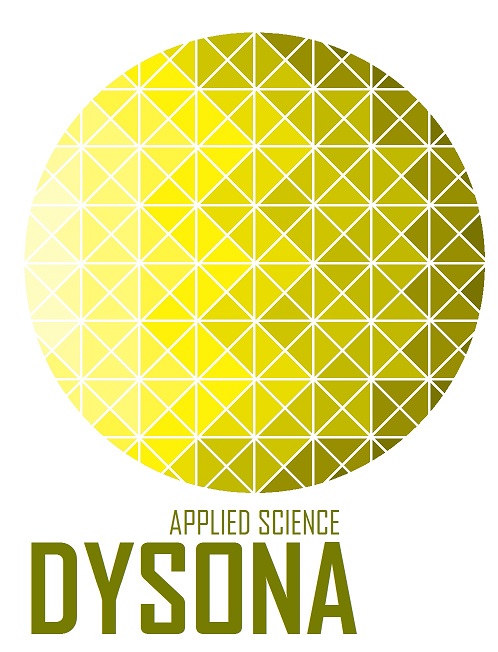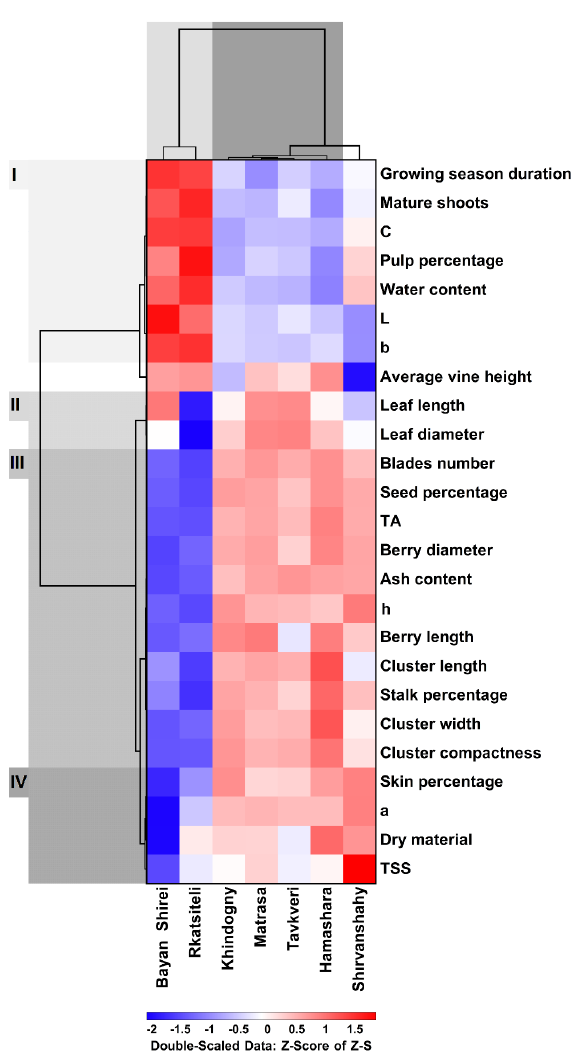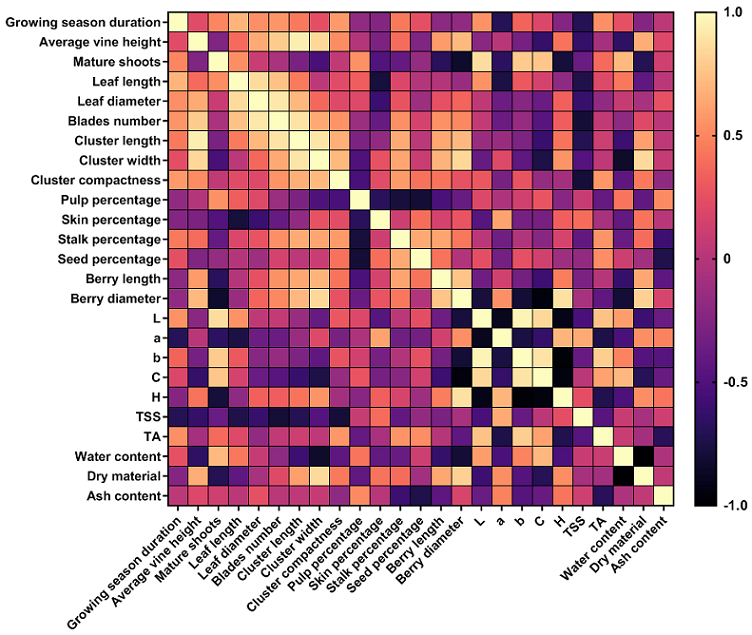Rauf Asadullayev ¹*; Khuraman Abasova ¹; Khadija Mammadova ¹; Aynura Guliyeva ¹
1, Scientific Research Institute of Viticulture and Wine-making, Ministry of Agriculture, AZ0118, Mehdiabad settlement, Absheron region, Azerbaijan
E-mail:
asadullayevrauf@gmail.com
Received: 22/08/2024
Acceptance: 23/09/2024
Available Online: 24/09/2024
Published: 01/01/2025

Manuscript link
http://dx.doi.org/10.30493/DAS.2024.474693
Abstract
The quality of grapes is influenced by factors including soil composition, climatic conditions, agricultural technology, plant age and development, meteorological factors, and disease prevalence. This study sought to characterize various widely cultivated grape cultivars growing in the Absheron Peninsula, Azerbaijan. The study analyzed the biochemical characteristics of fruit and classified key vine and cluster traits to explore potential correlations and improve understanding of the viability of each cultivar. Total soluble solids (TSS) ranged from 17.1% in Bayan Shirei to 23.3% in Shirvanshahy, suggesting that Shirvanshahy is optimally adapted to the climate. Titratable acidity (TA) ranged from 4.8 g/L in Matrasa to 5.95 g/L in Bayan Shirei. Bayan Shirei grapes exhibited the highest water content and the lowest proportion of dry matter, whereas Hamashara grapes displayed the lowest water content and the highest proportion of dry matter. Cluster analysis revealed that the content of organic matter (including soluble solids) is independent of the inorganic matter content in fruit, indicating separate pathways for the accumulation of these components in grapes. The ability of Shirvanshahy and Rkatsiteli to attain high sugar concentrations while maintaining moderate acidity highlights their adaptability to the semi-arid environment of the Absheron Peninsula.
Keywords: Vitis vinifera, Grape cultivars, Absheron Peninsula, Total soluble solids, Titratable acidity, Cluster
Introduction
Grapes (Vitis vinifera L.) are regarded as one of the most valued fruits globally due to their superior dietary and organoleptic properties. The elevated sugar content makes this fruit an excellent source of energy in the human diet. Additionally, this fruit contains diverse polyphenols (anthocyanins, flavonoids, flavanols, and resveratrol [1]), amino acids, and vitamins (C and K) in varying concentrations, underscoring its significance for human health. Tartaric and malic acids are the primary organic acids in grapes, while citric acid is found in specific grape varieties.
The primary quality indicators of grapes include sugar content, total acidity, active acidity (pH), amino acids, and proteins. However, the key variables influencing the technological value of grapes are the sugars, specifically glucose and fructose. The quality of grape berries, while inherently linked to their genetic characteristics, can fluctuate based on soil and climatic conditions of the cultivation area, agricultural practices (including planting, tillage, planting zone, cultivation system, training, pruning, load rate, green pruning, nutrition, irrigation, etc.), the age and development of the plant, annual meteorological conditions, and the extent of disease and pest infestations.
A negative correlation typically exists between grape yield and the sugar content of berry juice, which is exacerbated by current climatic changes [2]. The soil factor significantly affects the development of minerals and organic matter in the berries. Data indicate that for every 100 m increase in elevation, the sugar content in the berries diminishes by 0.8-1%, whereas the acidity escalates by 0.9 g/dm³ [3]. The technological characteristics of white and red grapes differ significantly, with total soluble solids (TSS) typically ranging from 17% to 23% in white grape cultivars and from 20% to 25% in red grapes [4][5]. Consequently, comprehending the environmental impact and its interaction with the genetic makeup of grape cultivars is essential in grape production and technology.
The extensive variety of grape cultivars grown in various regions of Azerbaijan [6] is attributable to the country’s diverse climatic conditions. Given the anticipated rise in global and national temperatures, together with frequent droughts and low precipitation, it is essential to select cultivars that are resilient to arid and hot conditions and to expand their production regions. This study attempted to describe several extensively planted grape cultivars growing under the conditions of the Absheron Peninsula. The research examines the biochemical properties of fruit and categorizes the primary vine and cluster traits to investigate potential relationships and enhance comprehension of the suitability and potential of each cultivar.
Material and Methods
Study area soil and climate
The research was carried out in the Absheron Ampelographic Collection at the Azerbaijan Scientific Research Institute of Viticulture and Winemaking. The Absheron Peninsula is situated on the western shore of the Caspian Sea, at an elevation of 20-28 meters above sea level, and extends from the southwestern periphery of the Greater Caucasus Range. The predominant soils are gray-sandy and loamy so and the humus layer attains a depth of 50-70 cm, whereas the illuvial-carbonate layer is situated on firm calcareous bedrock. The climate classification is dry-subtropical with arid summers. Intense northern winds mitigate elevated summer temperatures. Winters are comparatively temperate, predominantly cloudy, frequently rainy, and occasionally snowy. The mean annual air temperature ranges from 13.5 to 14.4°C, the cumulative active temperatures span from 4192 to 4461°C, with 308 annual frost-free days, and 220 to 230 annual sunny days. Absheron is among the driest regions in Azerbaijan with an average annual precipitation between 202 and 311 mm. The majority of annual precipitation (55-75%) occurs throughout the spring and summer months. January is the coldest month, with temperatures ranging from 3.0 to 3.8°C. The peak average monthly temperature occurs in July-August, reaching an absolute maximum of 42°C. Annual solar radiation varies between 120-135 kcal/cm², with the majority (80-90 kcal/cm²) occurring during the warmer period of the year. The peninsula’s territory is subject to the impact of severe winds, which augments plant transpiration; yet, elevates evaporation resulting in soil desiccation [7-9].
Grape Cultivars
The study concentrated on five indigenous grape (Vitis vinifera L. Subsp. Sativa) cultivars (Bayan Shirei, Khındogny, Hamashara, Matrasa, and Shirvanshahy) and two Georgian dual purpose grape cultivars (Tavkveri and Rkatsiteli), which are extensively cultivated in Azerbaijan and are part of the Ampelographic Collection at the Research Institute of Viticulture and Winemaking (Table 1) (Fig. 1).


(A) Doris Schneider, Julius Kühn-Institut (JKI), Federal Research Centre for Cultivated Plants, Institute for Grapevine Breeding Geilweilerhof – 76833 Siebeldingen, Germany [10]
(F) Ursula Brühl, Julius Kühn-Institut (JKI) Bundesforschungsinstitut für Kulturpflanzen Institut für Rebenzüchtung Geilweilerhof – 76833 Siebeldingen – Germany [10]
(G) Doris Schneider, Julius Kühn-Institut (JKI), Federal Research Centre for Cultivated Plants, Institute for Grapevine Breeding Geilweilerhof – 76833 Siebeldingen, Germany [10]
Grape cultivars monitoring
The study spanned three years (2021-2023) and involved ten trees from each cultivar. Twenty-five characteristics of vines, leaves, cluster, in addition to berries visual and biochemical attributes were investigated in the grape cultivars. All agricultural procedures, including irrigation, fertilization, and disease management, were standardized among the inspected vines. Harvest took place at the recognized maturation stage for each cultivar (Fig. 1).
Vine traits: Growing season duration was measured from bud burst until harvest in days, Average vine height (cm) was measured from ground surface to the highest shoot, Mature shoots (canes) percentage (%) was calculated based on the number of woody shoots entering dormancy by the end of the season
Leaves traits: Leaf length (Longest axis in cm) and Leaf diameter (Shortest axis in cm) were measured, and Blades number per leaf were counted.
Cluster traits: Cluster length (Maximum length in cm), Cluster width (Maximum width in cm), and Cluster compactness on a scale from 1 to 5 (Not compacted at all and Very compacted, respectively) were recorded. Pulp percentage (%), Skin percentage (%), Stalk percentage (%), and Seed percentage (%) were determined based on the total cluster weight. Clusters were pressed using a grape press and an electronic scale was used to determine the weight of each portion.
Visual traits of the berries: Berry length (mm) and Berry diameter (mm) were measured. Berry skin color was represented in CIELAB color space (L*, a*, and b*) using a colorimeter (Konica Minolta), Chroma (C) and hue (h) values were also determined using the same device.
Biochemical attributes of the berries: Berry juice was extracted and filtered. A hand held refractometer was used to determine total soluble solids (TSS%) in the extracted juice. Titratable acidity (TA g/L) in the juice was determined by titrating 10 ml of filtered grape juice with 0.1N NaOH and sitting the endpoint at a pH of 8.2 using an electronic pH-meter. TA (g/L) was then calculated using the following formula:
TA (g/L) = VNaOH × N × Eq / VJuice
Where:
VNaOH is the volume of the used base (NaOH) in the titration process
N is the normality of the used base (0.1)
Eq is the equivalent weight of the dominant acid in the juice (Eq for tartaric acid =75g)
VJuice is the volume of the used juice (10 ml)
Water content (%), Dry material (%), and Ash content (%) in berries were determined as follows: The initial mass of fresh berries was recorded (W1). The berries were halved to expedite the drying process and subsequently dried in an oven at 105 °C until a constant weight (W2) was achieved. The dry material was incinerated in a muffle furnace at 550 °C for 5 hours, and the ash weight was documented (W3). The previously indicated percentages were then computed as follows:
Water content (%) = (W1-W2)/W1
Dry material (%) = 100 – Water content (%)
Ash content (%) = W3/W1
Statistical analysis
One-way analysis of variance (ANOVA) and Tukey’s HSD test (p<0.05) were used to compare the means of the biochemical attributes of the berries. Ward linkage cluster analysis was used to classify the studied traits and grape cultivars. Furthermore, Pearson’s correlation coefficient (r) between the studied traits was calculated.
Results and Discussion
Fruit characteristics of grape cultivars
Total soluble solids (TSS) varied from 17.1% in Bayan Shirei to 23.3% in Shirvanshahy, with no significant differences in TSS content noted among the other cultivars (Fig. 2 A). Given that TSS indicates sugar content in grapes, these observations imply that Shirvanshahy is well-suited for the climate of the Absheron Peninsula, as a more favorable climate correlates with increased sugar accumulation in grapes [11].
Titratable acidity (TA) varied from 4.8 g/L in Matrasa to 5.95 g/L in Bayan Shirei. The variations in TA were largely negligible among the examined cultivars, with the exception of the differences between Bayan Shirei (higher end) and Matrasa and Tavkveri (lower end) (Fig. 2 B). From a production perspective, elevated acidity levels, exemplified by Bayan Shirei, are essential for preserving the crispness of wines, especially in warmer climates where acids are prone to rapid degradation [12]. Conversely, grapes with diminished acidity levels (Matrasa and Tavkveri) yield smoother and less astringent wines.
Bayan Shirei exhibited the highest water content and the lowest percentage of dry material, whereas Hamashara grapes displayed the lowest water content and the highest percentage of dry material (Fig. 2 C and D). The reduced water content in Hamashara grapes may result in more pronounced flavor profiles, similar to grape cultivars grown under conditions of water scarcity [13]. Nevertheless, additional factors must be considered, including TSS content, TA levels, and aroma profiles, which are intricate elements influenced by both genetics and environmental conditions.
The maximum ash content was observed in Tavkveri grapes (5.56%), whereas the minimum was noted in Bayan Shirei (3.72%) (Fig. 2 E). Ash primarily consists of potassium, calcium, and magnesium, which are essential elements for the activity and viability of yeasts during fermentation. Consequently, elevated ash content may correlate with a more robust fermentation process, which is crucial for wine quality and flavor intricacy.
Shirvanshahy and Rkatsiteli’s capacity to accumulate elevated sugar levels while preserving moderate acidity underscores their adaptability to the semi-arid conditions of the Absheron Peninsula. Consequently, these cultivars may flourish in arid, high-temperature environments, akin to other Mediterranean areas where thermal stress can augment specific advantageous grape characteristics [14].

Cluster analysis of grape cultivars traits
Ward linkage cluster analysis showed that the cultivars under investigation can be divided into two groups. As expected, the first group consisted of the white grapes’ cultivars (Bayan Shirei and Khindogny), since many traits including vine, cluster, visual, and biochemical traits while extremely similar in these two cultivars. On the other hand, the second group was constituted of the rest red grape cultivars (Fig. 3).
As for the clustering of the studied traits, four distinctive groups (I – IV) were identified, with average vine height being independent from these groups. The first group (I) consisted of most colorimetric indices (L*, b*, and C), pulp and water percentages in the cluster, growing season duration, and mature shoots percentage, illustrating a close connection between these traits within the studied cultivars. Leaf dimensions indices (length and width) were classified into a separate cluster (II), highlighting the strong correlation between these two traits (Fig. 3).
Interestingly, ash percentage belonged to the third cluster (III), while dry matter percentage in the fruit and TSS were included in the fourth cluster (IV). This observation might indicate that organic matter (including soluble solids) synthesis and accumulation pathway is independent than that of non-organic matter (minerals) accumulation in fruit.

Correlation analysis of grape cultivars traits
The correlation between all monitored characteristics in the studied cultivars under study conditions was investigated (Fig. 4). Cluster length and width were positively correlated (r=0.895, p<0.01). Furthermore, vine height was positively correlated with both cluster length (r=0.934, p<0.01) and width (r=0.833, p<0.05), which might indicate that larger clusters tend to be associated with taller vines. this relation suggests that vine vigor (represented here by vine length) could influence cluster size. Thus, managing vine height through pruning and canopy management could be a strategic approach to influence cluster morphology.
Leaf dimensions (length and width) were significantly correlated (r=0.854, p<0.05). Additionally, a significant negative relation (r=-0.788, p<0.05) was observed between skin percentage in the cluster and leaf length. In fact, the long exposure to sun light and high temperature, usually associated with low leaf area or defoliation [15], could have influenced skin development in the cultivars with higher skin ratio, which justifies the negative correlation between leaf size (length) and skin percentage in cluster. Therefore, selecting grape cultivars with higher leaf area index and decreasing defoliation practices can indirectly increase pulp ratio through decreasing skin ratio, especially in sunny and warm areas.
Titratable acidity (TA) exhibited a positive correlation with b* color component (r=0.789, p<0.05). In fact, b* color component is associated with the yellow-blue color range in the CIELAB color space. A more positive b* color component value indicates that the measured color is more yellow than it is blue. Therefore, it can be deduced than cultivars with positive b* values (white grape cultivars) were more acidic than those with negative b* values (red grape cultivars). Similar observation was reported previously as tartaric, citric, oxalic, succinic and lactic acids were found to be significantly higher in red grape cultivars compared to red grape cultivars [16].

Interestingly, total soluble solids (TSS) were negatively correlated with cluster compactness (r=-0.797, p<0.05), implying that more compact clusters might be associated with lower sugar content. Although more aesthetically pleasing, cluster compactness is usually considered a disadvantage in grapes production, since higher bunch rot incidence can occur in compacted clusters [17] prompting a more intensive disease control program. Additionally, a more compacted bunch is usually correlated with a decrease in TSS and increase in TA, as seen in the current work and previous researches, negatively affects the sensory and manufacturing properties of the produced grapes. Therefore, and since some of the cultivars grown in study area (Bayan Shirei, Khindogny, and Hamashara) are characterized with highly compacted clusters, considering bunch thinning treatments, such as gibberellic acid (GA) sprays [18], can positively enhance fruit qualities through decreasing cluster compactness.
Conclusion
This study investigated grape cultivars in the Absheron Peninsula, Azerbaijan, focusing on the vine, cluster, and berries visual and biochemical characteristics. The findings demonstrated that Shirvanshahy grapes are optimally adapted to the semi-arid climate of the Absheron Peninsula. The ability of Shirvanshahy and Rkatsiteli cultivars to attain high sugar concentrations while maintaining moderate acidity highlights their adaptability to semi-arid conditions and warrants an expansion of their cultivation in similar climates.
References
- Xia EQ, Deng GF, Guo YJ, Li HB. Biological activities of polyphenols from grapes. Int. J. Mol. Sci. 2010;11(2):622-46. DOI
- Kaltbach P, de Andrade Kaltbach SB, Domingues F, Herter FG, Costa VB. Relationship between the El Niño-Southern Oscillation and yield and sugar content of wine grapes grown in Santana do Livramento, RS, Brazil. Semina:Cienc. Agrar. 2022;43(5):2031-44. DOI
- Mercenaro L, de Oliveira AF, Cocco M, Nieddu G. Yield and grape quality of three red grapevine cultivars (Vitis vinifera L.) in relation to altimetry. In BIO Web of Conferences. 2019;13:02002. DOI
- Bisson LF, Waterhouse AL, Ebeler SE, Walker MA, Lapsley JT. The present and future of the international wine industry. Nature. 2002;418(6898):696-9. DOI
- Jackson RS. Wine tasting: a professional handbook 2nd edition. Elsevier. 2009. DOI
- Salimov V, Shukurov A, Asadullayev R. Study of diversity of Azerbaijan local grape varieties basing on OIV ampelographic descriptors. Ann. Agrar. Sci. 2017;15(3):386-95. DOI
- Panahov TM, Salimov VS. Grape varieties of Azerbaijan. – Baku: Muallim. 2012
- Negrul AM. Ampelography of Azerbaijan SSR. Baku; State Publishing House. 1973
- Westphal MI, Mehtiyev M, Shvangiradze M, Tonoyan V. Regional climate change impacts study for the South Caucasus region. Report, United Nations Development Programme, New York City. 2011.
- VIVC (Vitis International Variety Catalogue). Data and images retrieved in Aug 2024. Link
- Mullins MG, Bouquet A, Williams LE. Biology of the grapevine. Cambridge University Press. 1992.
- Jackson RS. Wine science: principles and applications. Academic press; 2008 Apr 30.
- Ojeda H, Andary C, Kraeva E, Carbonneau A, Deloire A. Influence of pre-and postveraison water deficit on synthesis and concentration of skin phenolic compounds during berry growth of Vitis vinifera cv. Shiraz. Am. J. Enol. Vitic. 2002;53(4):261-7.
- Jones GV, White MA, Cooper OR, Storchmann K. Climate change and global wine quality. Clim. Change. 2005;73(3):319-43. DOI
- Poni S, Bernizzoni F, Civardi S, Libelli N. Effects of pre‐bloom leaf removal on growth of berry tissues and must composition in two red Vitis vinifera L. cultivars. Aust. J. Grape Wine Res. 2009;15(2):185-93. DOI
- Cheng B, Zhang J, Xu H, Hou L, Wang Y, Zhang Y, Wang C. Analysis of organic acid contents in wine grape from different cultivars. Food Sci. 2013;34:223-8.
- Hed B, Ngugi HK, Travis JW. Relationship between cluster compactness and bunch rot in Vignoles grapes. Plant Dis. 2009;93(11):1195-201. DOI
- Hed B, Ngugi HK, Travis JW. Use of gibberellic acid for management of bunch rot on Chardonnay and Vignoles grape. Plant Dis. 2011;95(3):269-78. DOI
Cite this article:
Asadullayev, R., Abasova, K., Mammadova, K., Guliyeva, A. Assessment of grape cultivar traits and environmental adaptation in the Absheron Peninsula, Azerbaijan. DYSONA – Applied Science, 2025;6(1): 51-59. doi: 10.30493/das.2024.474693

